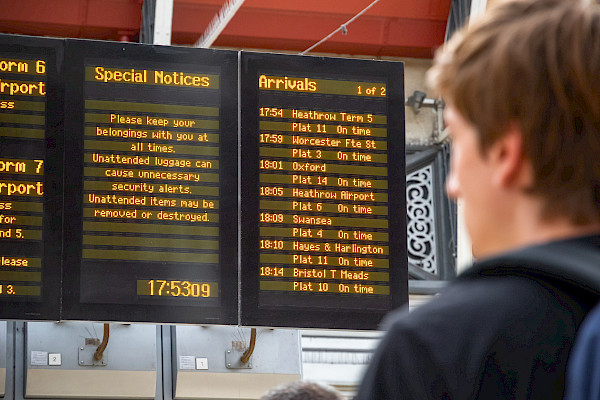
5 Nov 2025
Getting the trains to run on time
A clock-face timetable is a system under which public transport services run at consistent intervals. Many railway administrations over many years have designed timetables under this guiding principle. Their characteristics of repetition and predictability make it easier for staff to advise travellers, and for travellers to remember important details.
Research has recognised the commercial value of clockface patterns, and they are commonplace in mainland Europe, most notably in the Swiss network. They also represent good working practice: they make timetable planning, particularly the organisation of connections and rostering of crews, easier.
Moreover standard hours can guide investment toward optimal improvement of the infrastructure.
Here is an example of what happens when there is no guiding principle in timetable planning, and why it is crucial for Great British Railways [GBR] to adopt rigorous clockface standards as it redesigns the national timetable.
The Timetabling challenge
A ‘train path’ is defined as “the infrastructure capacity needed to run a train between two places over a given time-period.”
Each train path is specified by sectional running times. Timetable planning brings these paths together by determining the safe separation of trains by use of signals, and avoiding conflicts at junctions and crossovers.
The actual path is set by departure time and is selected by the planner based on a) how often they run, and b) their connection with other trains. This requirement to plan is rail’s potential strength as it makes it a safer way to travel than car, but it depends upon clear-sighted planning to reap the benefits.
The current planning process is that each train operating company [TOC] acquires from the Office of Rail and Road rights to paths that are specified without reference to detailed feasibility. It is then the task of Network Rail to join the independent specifications together within a set of operational rules and the stipulations of competition law.
This is difficult where the capacity of a route is over-subscribed, and TOCs can insist on their rights through an appeals process.
Network Rail’s timetabling process no longer considers interchange between services. The consequence is often that travellers using a journey planner are offered long waits between trains.
When the extensively-revised East Coast Main Line [ECML] timetable was published, I checked the planned sequence of services at York, and discovered anomalies in the scheme for connections between London and Scarborough. This is an illustration of the damaging consequences of privatisation and fragmentation.
Poor scheduling means you have to wait longer for trains
If you are travelling to Scarborough from London and you change at York, the minimum time stipulated to allow you to get from one train to another, and continue your onward journey, is 8 minutes. Where there is only a 7 minute interval between trains, rather than the minimum, the National Rail journey planner algorithm will show you an earlier train from London.
It appears that the planners have chosen not to delay these departures by one minute to maintain the required interchange margin of 8 minutes.
The consequence is considerable variation. The current timetable shows a near-perfect pattern for journeys from London to Scarborough; all departures from King’s Cross (except the last) are at xx:00 and arrivals at Scarborough only vary by a few minutes. By contrast the new timetable adds 6 minutes to the average journey-time, much of which is due to the longer waiting times at York. It also means 7 permutations of arrival and departure platforms.
This lack of a sustained pattern is not the only problem. Because more than one train company is involved, your journey may include different types of train (older diesels), different capacities of train (five coaches rather than at least nine) and different customer-service specifications – without being made aware of these facts – other than by notes about ticket restrictions and different policies for bikes. This is highly misleading.
Involving multiple operators means that the revenue for the onward journeys to Scarborough will be transferred from publicly-owned LNER to the private coffers of an American open-access company, all for a one minute difference in the connection times at York.
(Incidentally the National Rail journey planner shows ‘the lowest priced fare’ for each single-direction journey-opportunity. They differ for almost every service. In the existing timetable they range from £136.10 down to £51.90. This elaborate system must bewilder enquirers, and one must wonder how much effect it has on their choice of train.)
Conclusions
The Network Rail timetabling teams have undertaken the hugely complex task of weaving all manner of operators’ rights into a workable timetable. Such minute by minute methods are inefficient.
The problem is partly down to the very cleverness of the journey planner. It seems so all-powerful that few challenge its output, and there is no systematic identification of anomalies that may be denying the industry potential revenue.
If multiple independent operators are able to assert their own, narrow interests, then the ability of railway timetable planners to create a consistent, reliable, replicable solution is put at risk.
This is no way to run a railway.
Jonathan Tyler
Passenger Transport Networks, YORK
Author bio: After graduating in history from Trinity College in the University of Cambridge Jonathan joined British Rail as a Traffic Apprentice. He managed a marshalling yard, undertook original analysis of passenger demand at BR headquarters, contributed to strategic studies and was appointed BR Lecturer at the University of Birmingham. Since 1983 he has been an independent consultant specialising in timetable planning.

